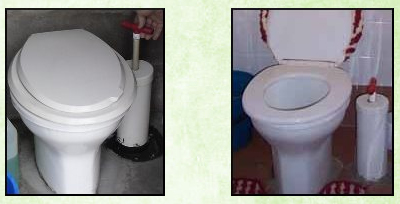
Jerry Epps at Teach Democracy.org shares his thoughts on three types of natural toilets. Jerry plans to have product for sale by November 1 this year. The natural toilets would be for use in remote areas anywhere they can use overland shipping (USA, Canada, Northern Mexico). Shipping product overseas is cost prohibitive.
Jerry hopes to franchise to other countries. He will teach them how to manufacture and assemble and they will be licensed as franchisee to do the business of marketing and sales of the Eppivent.
“Three Categories of Natural, No-flush Toilets
For people living in the developed world, having a flush toilet to carry away their human wastes is not a big deal. Having the water readily available with which to flush and having the electricity readily available with which to operate the pumps that deliver water under pressure to their toilet just seems ordinary. Also seeming ordinary is the massive, mostly out of sight, sewage handling infra structure that carries away the entire neighborhood’s waste to a treatment facility where it is processed and made ready for reuse. Most flush toilet users have heard that our fresh water supply is getting scarce, but few have felt the serious pinch yet.
In the undeveloped world, electricity, if available at all, is often rationed, and even the rationing schedule can be unreliable. Water is scarce too. Having a flush toilet is out of the question for these people—even if they could afford it, and most can’t. Some say, in a world where water is scarce and we have shortages, it is almost criminal that the flush toilet has been spread so widely and has become synonymous with wealth and luxury—a status symbol in much of the world. It has become idolized as the premier way to handle personal waste. How unfortunate that the flush toilet is so wasteful of a scarce resource and yet so desired. There are ways to handle our waste that are not nearly so dependent upon costly infrastructures and valuable resources.
There are three major categories of natural and no-flush toilets. They use neither water nor electricity. They are: 1) compost/aerobic, 2) anaerobic digester and 3) bio-mass/biofilter. Within each category there are several types and many models. There are electric or gas incinerating toilets too—but they need electricity or gas to operate. Even when electricity or gas are available, they are expensive energy compared to natural alternatives available. There are low flush toilets, but they still use water and require water and sewage infrastructures. Let’s look at the three categories of natural no-flush (waterless) toilets.”
Read the full article at Teach Democracy.org
Related: Rota-Loo

how about anyone mentioned the book, HUMANURE? We have used for the last 6 years, in our outside, yes, we do live in the Mojave Desert, sometimes also cold! but no smell, tooo easy, gives us earth!!! a great gift for ourselves!! jehane
The Humanure sawdust is probably the simplest, best toilet. The plans and book are free online. However, some people don’t want a toilet like this and so people are proposing other options.
I took the well stated and cautionary advice of Phil Dodd and read the referenced article with interest. No wonder prudence is called for when departing from the world of flush toilets! The experience of those who had to undergo the dry toilet project was terrible. I can promise that if our power vented anaerobic digester toilet is not pleasantly functional I will pull it from the market. Also, our toilet is not “dry” as we do not separate urine from solid waste. After initial fill with water, urine provides the on going water needed by the system. The solar powered vent fan pulls out the bad smells. Also, a quick pass with the large cleanser soaked brush at the pan/bowl after use neutralizes any odor that might arise from the sides of the pan/bowl having been fouled during use.
I believe the Eppivent toilet will not present the problems referred to by Mr. Dodd. But I do appreciate his concern. We will try to get it right. Thanks
Thanks for the feedback. I trust your opinion.
It appears that care is needed to get all of the details right. According to an article in London’s Guardian newspaper, a dry scheme in China had to be closed down. But what went wrong with that particular implementation ? See this web article :
http://www.guardian.co.uk/environment/2012/jul/30/eco-toilet